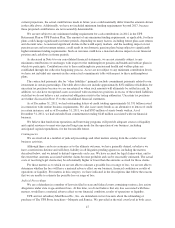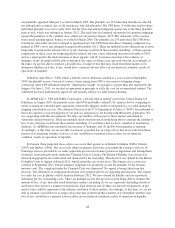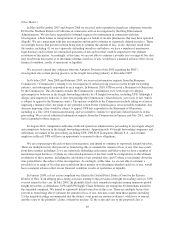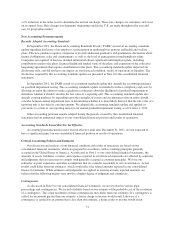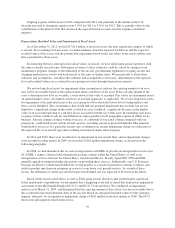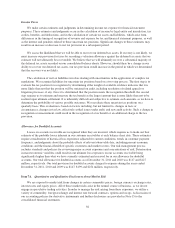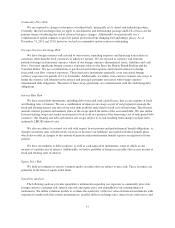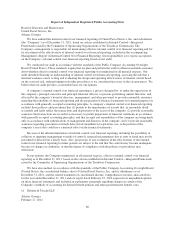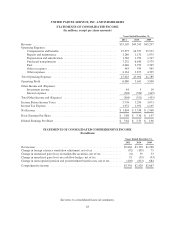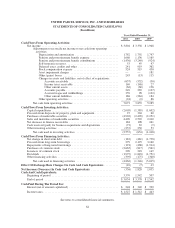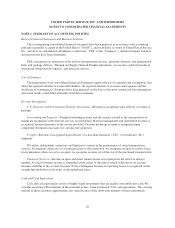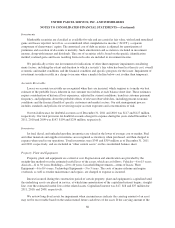UPS 2011 Annual Report Download - page 68
Download and view the complete annual report
Please find page 68 of the 2011 UPS annual report below. You can navigate through the pages in the report by either clicking on the pages listed below, or by using the keyword search tool below to find specific information within the annual report.Income Taxes
We make certain estimates and judgments in determining income tax expense for financial statement
purposes. These estimates and judgments occur in the calculation of income by legal entity and jurisdiction, tax
credits, benefits, and deductions, and in the calculation of certain tax assets and liabilities, which arise from
differences in the timing of recognition of revenue and expense for tax and financial statement purposes, as well
as the interest and penalties related to these uncertain tax positions. Significant changes to these estimates may
result in an increase or decrease to our tax provision in a subsequent period.
We assess the likelihood that we will be able to recover our deferred tax assets. If recovery is not likely, we
must increase our provision for taxes by recording a valuation allowance against the deferred tax assets that we
estimate will not ultimately be recoverable. We believe that we will ultimately recover a substantial majority of
the deferred tax assets recorded on our consolidated balance sheets. However, should there be a change in our
ability to recover our deferred tax assets, our tax provision would increase in the period in which we determined
that the recovery was not likely.
The calculation of our tax liabilities involves dealing with uncertainties in the application of complex tax
regulations. We recognize liabilities for uncertain tax positions based on a two-step process. The first step is to
evaluate the tax position for recognition by determining if the weight of available evidence indicates that it is
more likely than not that the position will be sustained on audit, including resolution of related appeals or
litigation processes, if any. Once it is determined that the position meets the recognition threshold, the second
step requires us to estimate and measure the tax benefit as the largest amount that is more likely than not to be
realized upon ultimate settlement. It is inherently difficult and subjective to estimate such amounts, as we have to
determine the probability of various possible outcomes. We reevaluate these uncertain tax positions on a
quarterly basis. This evaluation is based on factors including, but not limited to, changes in facts or
circumstances, changes in tax law, effectively settled issues under audit, and new audit activity. Such a change in
recognition or measurement could result in the recognition of a tax benefit or an additional charge to the tax
provision.
Allowance for Doubtful Accounts
Losses on accounts receivable are recognized when they are incurred, which requires us to make our best
estimate of the probable losses inherent in our customer receivables at each balance sheet date. These estimates
require consideration of historical loss experience adjusted for current conditions, trends in customer payment
frequency, and judgments about the probable effects of relevant observable data, including present economic
conditions and the financial health of specific customers and market sectors. Our risk management process
includes standards and policies for reviewing major account exposures and concentrations of risk. Deterioration
in macroeconomic variables could result in our ultimate loss exposures on our accounts receivable being
significantly higher than what we have currently estimated and reserved for in our allowance for doubtful
accounts. Our total allowance for doubtful accounts as of December 31, 2011 and 2010 was $117 and $127
million, respectively. Our total provision for doubtful accounts charged to expense during the years ended
December 31, 2011, 2010 and 2009 was $147, $199 and $254 million, respectively.
Item 7A. Quantitative and Qualitative Disclosures about Market Risk
We are exposed to market risk from changes in certain commodity prices, foreign currency exchange rates,
interest rates and equity prices. All of these market risks arise in the normal course of business, as we do not
engage in speculative trading activities. In order to manage the risk arising from these exposures, we utilize a
variety of commodity, foreign exchange and interest rate forward contracts, options and swaps. A discussion of
our accounting policies for derivative instruments and further disclosures are provided in Note 15 to the
consolidated financial statements.
56



